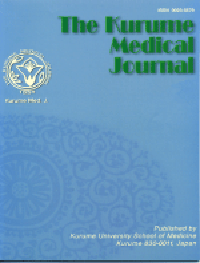All issues

Volume 58, Issue 3
Displaying 1-5 of 5 articles from this issue
- |<
- <
- 1
- >
- >|
Original Contribution
-
ATSUHIKO KOGA, KEISHIRO AOYAGI, TAKUYA IMAIZUMI, MOTOSHI MIYAGI, KAZUO ...2011 Volume 58 Issue 3 Pages 73-79
Published: November 30, 2011
Released on J-STAGE: April 24, 2012
JOURNAL FREE ACCESSPeritoneal metastasis is the most common form of recurrence in gastric cancer, and is associated with a poor prognosis. It is clear that many agents are involved at the various stages of this process, however, many aspects of the progression remain unclear. In the present study we compared the gastric cancer cell line MKN-45 with the high-potential peritoneal dissemination gastric cancer cell line MKN-45P, established from MKN-45. The supernatant of culture medium of MKN-45 cells or MKN-45P cells was collected, and the concentrations of interleukin-1β (IL-1β), IL-6, IL-8, hepatocyte growth factor (HGF), Transforming growth factor beta-β1 (TGF-β1), vascular endothelial growth factor (VEGF), matrix metalloproteinase-2 (MMP-2), MMP-9, and tissue inhibitor of metalloproteinase-1 (TIMP-1) proteins were measured using an enzyme-linked immuno sorbent assay (ELISA) method. Invasion, wound healing and adhesion assays were performed in vitro to examine interstitial invasion, migration and adhesion in the gastric cancer cell lines. Moreover, Western blotting was performed to determine the expression of cyclooxygenase-1 (COX-1) and COX-2 proteins in the culture media of the cell lines. The concentrations of IL-6, IL-8, VEGF and MMP-2 protein in the culture supernatant of MKN-45P were significantly higher than those of MKN-45. Percent adhesion of MKN-45P was significantly higher than that of MKN-45 in the fibronectin-coated group. There was no significant difference in invasion or migration between MKN-45 and MKN-45P. COX-1 and COX-2 proteins were observed in both cell lines. These results suggested that secretion of IL-6, IL-8, VEGF and MMP-2 from cancer cells, and adhesion of cancer cells to fibronectin, were related to the establishment of peritoneal dissemination.View full abstractDownload PDF (612K)
Case Reports
-
YASUKO MIZUSHIMA, RIN YAMAGUCHI, TOSHIRO YOKOYAMA, ETSUYO OGO, OSAMU N ...2011 Volume 58 Issue 3 Pages 81-85
Published: November 30, 2011
Released on J-STAGE: April 24, 2012
JOURNAL FREE ACCESSInvasive micropapillary carcinoma (IMPC) of the breast is a distinct variant of breast cancer. Extensive lymphatic penetration, lymph node metastasis, and local recurrence are seen at a relatively high frequency. On ultrasound (US) findings, IMPC has been reported to be an irregular or lobulated mass with hypoechoic internal areas, but as yet there is no consensus regarding typical findings. A 52-year-old female noticed a mass less than 3 cm in diameter in her left upper breast. US findings indicated an irregularly shaped, hypoechoic tumor with indistinct margins. The diagnosis according to fine-needle aspiration cytology was invasive ductal carcinoma. She underwent lymph node dissection with mastectomy of the left breast. Histological examination revealed mixed-type IMPC. Three years and three months after surgery, IMPC recurred under the skin of the surgical scar. US findings indicated a hyperechoic tumor in this region. Eight months after further surgery, a tumor in the anterior chest wall was observed. US findings indicated an oval hypoechoic tumor with posterior acoustic enhancement. US findings differed between primary and recurrent IMPC because of differences in the occupancy and distribution of IMPC. We describe here a comparison between US and histological findings, as well as differences in IMPC between primary, secondary and tertiary sites.View full abstractDownload PDF (794K) -
TAKEHARU KOGA, RUMI SATO, TOMOKO KAMIMURA, MUNETSUGU NISHIMURA, MASAYO ...2011 Volume 58 Issue 3 Pages 87-90
Published: November 30, 2011
Released on J-STAGE: April 24, 2012
JOURNAL FREE ACCESSAn 82-year-old woman was admitted to our hospital after multiple round opacities were detected in chest X-rays performed during a routine health screening. Mycobacterium avium complex (MAC) was found in sputum cultures, and compatible pathological findings on biopsy confirmed pulmonary MAC infection, whereas biopsies from another opacity revealed adenocarcinoma of the lung.
Curative surgery for the lung cancer confirmed a concurrence of lung cancer and pulmonary MAC infection. Since the prevalence of both of these lung diseases is increasing, suspicion of concurrence is critical to provide appropriate care.View full abstractDownload PDF (762K) -
AKIO KATAOKA, SHOUKO HIRAKAWA, MANAMI IWAMOTO, YUMI SAKUMURA, RYOUTA Y ...2011 Volume 58 Issue 3 Pages 91-94
Published: November 30, 2011
Released on J-STAGE: April 24, 2012
JOURNAL FREE ACCESSAlthough still an experimental procedure, it is hoped that oocyte intrauterine transfer (OUT) could become a convenient technique for initiating pregnancy. A 33-year old woman received OUT treatment after a period of infertility lasting for 3 years. Two weeks later the result of pregnancy test was positive, but shortly thereafter she complained of vaginal bleeding. Ultrasonography revealed a cystic lesion in her right adnexal area without any ascites. At laparotomy, a right side tubal pregnancy was confirmed. This is the first case report of ectopic pregnancy occurring after OUT. It was speculated that the OUT may have caused the tubal pregnancy. However, since the precise mechanism for embryonic implantation to the tubal epithelium is unknown, the causal relationship between OUT and tubal pregnancy remains unclear.View full abstractDownload PDF (692K) -
KOUSUKE UEDA, MASANORI NOGUCHI, SIGETAKA SUEKANE, FUKUKO MORIYA, RIKAK ...2011 Volume 58 Issue 3 Pages 95-98
Published: November 30, 2011
Released on J-STAGE: April 24, 2012
JOURNAL FREE ACCESSSince the introduction of targeted therapy, treatment of metastatic renal cell carcinoma (RCC) has undergone dramatic changes. Responses to targeted therapy within the primary tumor and metastatic lesions are novel findings not seen with immunotherapeutic-based strategies. We report here a case of T4 RCC in which cytoreductive nephrectomy became possible after a neoadjuvant targeted therapy using sunitinib. Our experience with the present case suggests that targeted therapy in the neoadjuvant setting may have a variety of potential applications. Further investigations should be encouraged.View full abstractDownload PDF (779K)
- |<
- <
- 1
- >
- >|